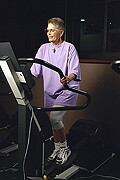
FRIDAY, May 15, 2015 (HealthDay News) — “Safe” levels of exercise differ for men and women with the common heart rhythm disorder known as atrial fibrillation, new research reports.
Using data from 14 studies involving 380,000 people with atrial fibrillation — a type of irregular heartbeat that affects many aging Americans and is tied to higher stroke risk — the study found that moderate and vigorous levels of exercise are safe for women with atrial fibrillation but vigorous exercise may be risky for men.
“Sustaining a workout routine can be intimidating for patients with atrial fibrillation because they are concerned about how it will further affect their heart beat and potentially trigger an atrial fibrillation episode,” lead author Dr. Sanghamitra Mohanty, senior researcher at the Texas Cardiac Arrhythmia Institute, explained in a news release.
In the study, slated for presentation Friday at the annual meeting of the Heart Rhythm Society in Boston, Mohanty’s team defined moderate exercise as 15 to 30 minutes of walking five times a week, or an activity such as yoga. Vigorous exercise was defined as activities such as running, swimming, bicycling and jogging.
Among women, the risk of an atrial fibrillation episode was reduced by 24 percent for those who engaged in moderate exercise, and by 15 percent with vigorous exercise.
In men, moderate exercise reduced the risk of an atrial fibrillation episode by 19 percent, but vigorous exercise raised the risk by 90 percent.
“Now that we know about the advantages of moderate physical activity in both men and women, we are able to provide specific tips and recommendations on how patients can exercise safely and at the same time benefit from the protective effect of exercise on atrial fibrillation and improve their overall quality of life,” Mohanty added.
One expert agreed.
“The importance of including data on gender-specific findings is critical in all areas of research and has yielded important and clinically relevant findings in the study of women and heart disease over the last 25 years,” noted Dr. Stacey Rosen, vice president of women’s health at The Katz Institute for Women’s Health in New Hyde Park, N.Y.
She believes that “this gender-based approach is particularly important in atrial fibrillation, which is a significantly more dangerous condition in women than men.”
That’s because “the stroke risk for women in atrial fibrillation is more than four times greater the risk of stroke in men, and even the death rates of women with atrial fibrillation is over two times greater than in men,” Rosen added.
Overall, the study shows that exercise is safe for people with atrial fibrillation, the study authors said. However, they advised that patients talk with their doctors to determine the best exercise plan to help them maintain heart health and prevent episodes.
According to background information in the study, atrial fibrillation affects more than 2.7 million American adults, and that number is expected to more than double in the next 30 to 40 years.
Experts note that findings presented at medical meetings are typically considered preliminary until published in a peer-reviewed journal.
More information
The U.S. National Heart, Lung, and Blood Institute has more about atrial fibrillation.
Copyright © 2025 HealthDay. All rights reserved.

